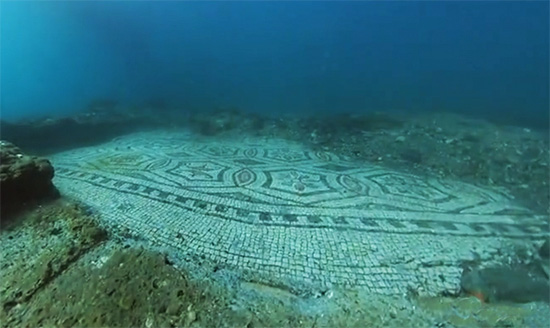Ancient Roman Mosaic Unearthed Underwater Near Naples: A Portal to the Past
A stunning Roman mosaic floor, once part of a luxurious villa, has been discovered submerged in the waters near Naples, Italy. This exquisite artifact, crafted during the late Roman Empire, offers a glimpse into the grandeur of life in Baiae, a city infamous for its hedonistic reputation. According to the Campi Flegrei Archaeological Park, the mosaic adorned the entrance porch, or "protiro," of the villa and is believed to date back to the third century C.E.
Baiae: The Roman Empire’s Playground
Dubbed the “Las Vegas of ancient Rome,” Baiae was a magnet for aristocrats and rulers seeking indulgence. It was a city synonymous with decadence, where power and wealth converged in a swirl of lavish parties and scandalous affairs. Figures like Julius Caesar and Emperor Nero owned properties in this opulent retreat, further solidifying its status as a hub of extravagance.
“It was absolutely a place of pleasure and debauchery,” said Candace Rice, an archaeologist at Brown University, during an interview with PBS’s Secrets of the Dead in 2017. She added, “The mere mention of Baiae brought to mind scandal and could ruin your reputation.”
The Mosaic: A Masterpiece of Opus Sectile
The unearthed floor is an example of "opus sectile," a mosaic technique that translates to “cut work” in Latin. Unlike traditional mosaics that use small, uniformly shaped tiles, opus sectile involves cutting materials into precise shapes to fit complex designs. This approach allowed for intricate geometric patterns and vibrant compositions, showcasing the artistic sophistication of the Roman elite.
In its prime, the villa occupied a breathtaking location overlooking the sea, symbolizing wealth and status. However, this prime spot also came with geological risks. The region’s proximity to the Phlegraean Fields, a sprawling volcanic area, led to the villa’s eventual submersion in the Gulf of Pozzuoli. The phenomenon responsible for this, known as bradyseism, involves the gradual sinking or rising of the ground due to subterranean pressure changes. Over time, the villa sank beneath the waves, preserving its architectural treasures under layers of sediment.
Restoration Efforts and Challenges
Today, the mosaic lies at the heart of extensive restoration efforts. The ancient floor, though visually striking, is highly fragile and has been broken into numerous pieces over centuries of submersion. Researchers have carefully retrieved portions of the mosaic, submerging them in freshwater to remove accumulated salt and stabilize the materials.
“The floor in opus sectile, with its elaborate geometric motifs and extraordinary craftsmanship, offers a fascinating window into the life and art of ancient Rome,” says Bacoli’s mayor, Josi Gerardo Della Ragione. He expressed his excitement about the discovery, which allows modern audiences to reconnect with the artistry of the past.
In addition to the mosaic, divers have uncovered fragments of the villa’s walls, which once towered up to 32 feet high. These walls, thought to have collapsed onto the mosaic during the villa’s descent, explain the damaged condition of the intricate designs. Despite these challenges, the team remains committed to piecing together this historical puzzle.
A Popular Dive Site and Archaeological Treasure
The Gulf of Pozzuoli has become a haven for divers drawn to its underwater ruins. Submerged fountains, baths, columns, and other structures from the ancient city create an underwater archaeological park that attracts visitors from around the world. This protected area not only preserves remnants of Roman engineering but also serves as a site for ongoing discoveries and research.
The mosaic adds to the region’s allure, offering a tangible connection to the lives of those who once strolled its lavish halls. By studying its craftsmanship and design, archaeologists hope to glean more insights into the social and cultural dynamics of the time.
The Legacy of Baiae’s Villa
Baiae’s reputation as a center of excess may have faded, but its legacy endures through the artifacts it left behind. The discovery of the mosaic highlights the architectural ingenuity and artistic prowess of the Roman Empire, as well as the challenges of preserving such treasures in an ever-changing landscape.
As restoration efforts continue, researchers aim to recreate portions of the mosaic on land, making it accessible to the public. This initiative not only ensures the artifact’s preservation but also allows people to experience a piece of ancient history up close. The painstaking work of recovering and restoring the mosaic reflects a broader commitment to understanding and celebrating the cultural achievements of antiquity.
A Window Into Roman Life
The luxurious villa at Baiae was more than just a residence; it was a statement of power and prestige. Its location, design, and decor all spoke to the wealth and influence of its owners. The mosaic floor, with its intricate patterns and vibrant colors, would have greeted guests with a display of artistic refinement, setting the tone for the grandeur within.
Candace Rice’s description of Baiae as a place of “pleasure and debauchery” underscores the dichotomy of Roman life—a civilization capable of incredible cultural and architectural achievements, yet marked by indulgence and moral complexity. The mosaic embodies this duality, serving as both a masterpiece of craftsmanship and a relic of a society where excess was the norm.
Future Discoveries and Implications
The ongoing exploration of Baiae and its underwater ruins holds the promise of even more discoveries. Each artifact recovered adds to the mosaic of history, providing context and depth to our understanding of Roman life. The villa’s collapse into the Gulf of Pozzuoli, while tragic, has inadvertently preserved its treasures, offering a unique opportunity to study a slice of ancient life frozen in time.
As archaeologists and divers continue their work, the mosaic stands as a symbol of resilience and cultural heritage. It reminds us of the fragility of human creations and the enduring allure of the past. Through careful preservation and study, the secrets of Baiae’s opulent villas will continue to captivate and inspire future generations.















0 commentaires: